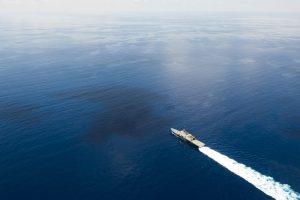On July 12, the tribunal responsible for the Philippines’ South China Sea case against China ruled unanimously and overwhelmingly in favor of Manila, determining that the extent of several parts of Beijing’s claim and its efforts to enforce it over the past few years were unlawful (See: “What the South China Sea Ruling Means”). Unsurprisingly, the verdict has raised questions about how this might affect U.S. policy.
I’ve got a piece out with the Brookings Institution that examines the opportunities and challenges for U.S. policy following the ruling (See: “US South China Sea Policy After the Ruling: Opportunities and Challenges”). Though I’d urge you to read the whole thing, in brief, I argue that in spite of the fact that the ruling has been seen as a victory of “right over might” and a boost for the rules-based international order that Washington and some of its allies and partners are championing, in reality this could also pose profound challenges for the future of U.S. South China Sea policy under the Obama administration and beyond.
The Obama administration’s South China Sea policy has been informed by both increasing concern about China’s assertive actions in the South China Sea as well as a reluctance to let the issue disrupt U.S.-China cooperation on other fronts, drown out the voices of regional states, or dominate U.S. Asia strategy. Following from that, the administration’s approach has rested on three pillars: a political pillar, which seeks to encourage claimant states to defuse tensions among themselves; a diplomatic pillar, where Washington tries to knit together a group of concerned global actors to stand up for the rules-based international order and against Chinese assertiveness: and a military pillar in which the United States seeks to build the capacity of Southeast Asian states as well as undertake its own efforts to resist Chinese aggression (See: “America’s New Maritime Security Initiative for Southeast Asia”).
At first glance, the ruling would appear to strengthen all three pillars. The additional clarity it provides would help set the parameters for claimants to resolve their disputes with each other; boost the arguments that Washington and other concerned global actors have been making about China’s unlawful activities; and inform military decisions to be taken in line with stated principles and preexisting commitments including freedom of navigation operations (FONOPs).
But the United States and its allies and partners are also likely to confront a series of challenges stemming from the ambiguities and uncertainties that still remain even after the verdict. First, getting parties to move toward resolving disputes or reduce tensions is much more complex than it seems. For instance, it is far from clear whether China has an incentive to move in this direction rather than take provocative actions (especially following the G-20 meeting in September) or simply ignore the ruling. And in the case of the Philippines under incoming president Rodrigo Duterte, an overenthusiasm to negotiate with China has already led to worries that Manila may give in to certain demands that could undermine Philippine interests or even the U.S.-Philippine alliance (See: “The Risks of Duterte’s China and South China Sea Policy”).
Second, the ruling could reveal the fragility of the informal diplomatic coalition that Washington has helped assemble in defense of the rules-based international order. If regional activism following the verdict is weak, the coalition risks being seen as “getting ahead” of the claimants themselves, thereby strengthening the Chinese narrative that outside actors are trying to stir up trouble in the South China Sea. And if there is inaction from allies and partners in U.S.-led initiatives, particularly when it comes to more forward-leaning and controversial measures like joint FONOPs, this would expose the gap between the coalition’s words and actions and reveal Washington’s isolation.
Third, the ruling could also end up raising questions about U.S. credibility on the South China Sea issue. Though Washington has used a mixture of unilateral military actions, bilateral dialogue, and capacity-building efforts to signal to China that provocative moves – like starting reclamation at Scarborough Shoal or declaring a South China Sea ADIZ – could trigger an even stronger American response, that also means that the United States must follow through on its pledge to act if these events occur or risk having its credibility undermined (See: “US-Philippines Alliance to Reach New Level: US Defense Chief”). Actions that affect the Philippines would constitute a particular problem for Washington in this sense, since Manila is a treaty ally and U.S. inaction would expose the emptiness of its “ironclad” commitment to the alliance.
To be sure, none of these challenges are insurmountable, and no path is preordained. But we ought to be cautious in focusing too much on the clarity that the ruling provides and the opportunities therein, rather than the ambiguities and uncertainties that remain and the challenges they pose.
You can read the full analysis here.

































